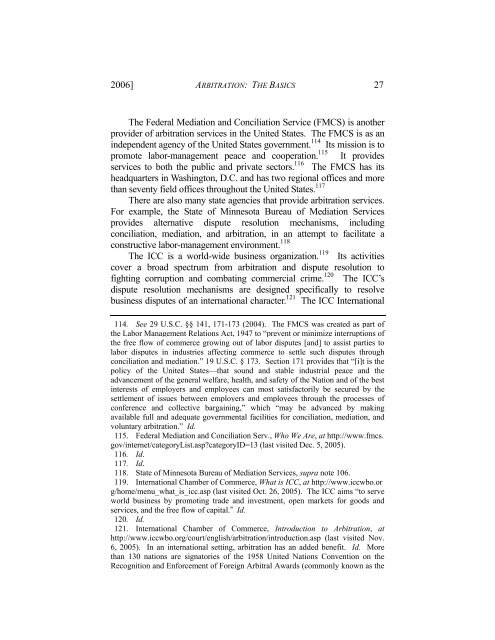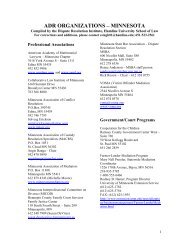2006/Vol. 5 No.1 - Hamline Law - Hamline University
2006/Vol. 5 No.1 - Hamline Law - Hamline University
2006/Vol. 5 No.1 - Hamline Law - Hamline University
You also want an ePaper? Increase the reach of your titles
YUMPU automatically turns print PDFs into web optimized ePapers that Google loves.
<strong>2006</strong>] ARBITRATION: THE BASICS 27<br />
The Federal Mediation and Conciliation Service (FMCS) is another<br />
provider of arbitration services in the United States. The FMCS is as an<br />
independent agency of the United States government. 114 Its mission is to<br />
promote labor-management peace and cooperation. 115 It provides<br />
services to both the public and private sectors. 116 The FMCS has its<br />
headquarters in Washington, D.C. and has two regional offices and more<br />
than seventy field offices throughout the United States. 117<br />
There are also many state agencies that provide arbitration services.<br />
For example, the State of Minnesota Bureau of Mediation Services<br />
provides alternative dispute resolution mechanisms, including<br />
conciliation, mediation, and arbitration, in an attempt to facilitate a<br />
constructive labor-management environment. 118<br />
The ICC is a world-wide business organization. 119 Its activities<br />
cover a broad spectrum from arbitration and dispute resolution to<br />
fighting corruption and combating commercial crime. 120 The ICC’s<br />
dispute resolution mechanisms are designed specifically to resolve<br />
business disputes of an international character. 121 The ICC International<br />
114. See 29 U.S.C. §§ 141, 171-173 (2004). The FMCS was created as part of<br />
the Labor Management Relations Act, 1947 to “prevent or minimize interruptions of<br />
the free flow of commerce growing out of labor disputes [and] to assist parties to<br />
labor disputes in industries affecting commerce to settle such disputes through<br />
conciliation and mediation.” 19 U.S.C. § 173. Section 171 provides that “[i]t is the<br />
policy of the United States—that sound and stable industrial peace and the<br />
advancement of the general welfare, health, and safety of the Nation and of the best<br />
interests of employers and employees can most satisfactorily be secured by the<br />
settlement of issues between employers and employees through the processes of<br />
conference and collective bargaining,” which “may be advanced by making<br />
available full and adequate governmental facilities for conciliation, mediation, and<br />
voluntary arbitration.” Id.<br />
115. Federal Mediation and Conciliation Serv., Who We Are, at http://www.fmcs.<br />
gov/internet/categoryList.asp?categoryID=13 (last visited Dec. 5, 2005).<br />
116. Id.<br />
117. Id.<br />
118. State of Minnesota Bureau of Mediation Services, supra note 106.<br />
119. International Chamber of Commerce, What is ICC, at http://www.iccwbo.or<br />
g/home/menu_what_is_icc.asp (last visited Oct. 26, 2005). The ICC aims “to serve<br />
world business by promoting trade and investment, open markets for goods and<br />
services, and the free flow of capital.” Id.<br />
120. Id.<br />
121. International Chamber of Commerce, Introduction to Arbitration, at<br />
http://www.iccwbo.org/court/english/arbitration/introduction.asp (last visited Nov.<br />
6, 2005). In an international setting, arbitration has an added benefit. Id. More<br />
than 130 nations are signatories of the 1958 United Nations Convention on the<br />
Recognition and Enforcement of Foreign Arbitral Awards (commonly known as the
















